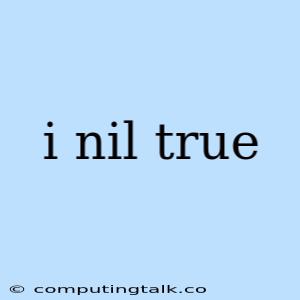In programming, the concept of "nil" or "null" represents the absence of a value. It's a fundamental concept in many programming languages, including languages like Swift, Objective-C, and Ruby, that have roots in Smalltalk.
Let's delve into the meaning of "nil" and how it contrasts with "true."
What is Nil?
Think of "nil" as an empty container. It signifies the absence of data or an object. Imagine you have a variable called "myCar." If "myCar" is "nil," it means you haven't assigned any specific car to that variable yet.
Why Use Nil?
Here are some reasons why "nil" is important:
- Representing the Absence of Data: "nil" allows you to represent a scenario where you don't have a value to work with.
- Error Handling: When you encounter an error or a situation where you expect a value but it's not present, "nil" can signal that issue.
- Flexibility in Data Structures: "nil" enables you to create flexible data structures where elements might be present or absent.
The Difference Between Nil and True
"nil" and "true" are distinct concepts with different meanings:
- "nil" represents the absence of a value. It's like saying "nothing is here."
- "true" represents a logical truth. It's a statement that is confirmed or verified.
Think of it like this:
- "Is there a car in the garage?" If the garage is empty, the answer is "nil" (no car).
- "Is the sun shining?" If it is indeed shining, the answer is "true."
Working with Nil in Programming
- Checking for Nil: It's essential to check for "nil" before attempting to use the value. This prevents unexpected errors.
- Handling Nil: When you encounter "nil," you'll often need to handle it gracefully. This might involve:
- Returning a default value
- Displaying an error message
- Taking a specific action depending on the context.
Practical Example:
Imagine you're writing a function to retrieve a user's name from a database. If the user doesn't exist, the function might return "nil."
func getUserName(userId: Int) -> String? {
// Check if the user exists in the database.
// ...
if userExists {
return "John Doe"
} else {
return nil
}
}
Here, the getUserName function returns a String?, which means it can return a String or nil. If the user doesn't exist, the function returns nil.
Conclusion
Understanding "nil" is crucial for effective programming in many languages. It's a fundamental concept that allows you to represent the absence of a value, handle errors, and create flexible data structures. By learning how to work with "nil," you'll be better equipped to write robust and reliable code.
